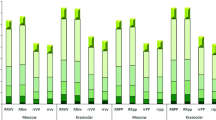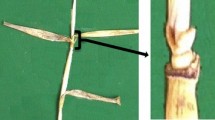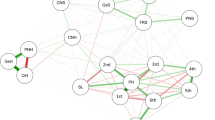Abstract
Near isogenic lines (NILs) varying for reduced height (Rht) and photoperiod insensitivity (Ppd-D1) alleles in a cv. Mercia background (rht (tall), Rht-B1b, Rht-D1b, Rht-B1c, Rht8c+Ppd-D1a, Rht-D1c, Rht12) were compared for interception of photosynthetically active radiation (PAR), radiation use efficiency (RUE), above-ground biomass (AGB), harvest index (HI), height, weed prevalence, lodging and grain yield, at one field site but within contrasting (‘organic’ vs. ‘conventional’) rotational and agronomic contexts, in each of 3 years. In the final year, further NILs (rht (tall), Rht-B1b, Rht-D1b, Rht-B1c, Rht-B1b+Rht-D1b, Rht-D1b+Rht-B1c) in Maris Huntsman and Maris Widgeon backgrounds were added together with 64 lines of a doubled haploid (DH) population [Savannah (Rht-D1b) × Renesansa (Rht-8c+Ppd-D1a)]. There were highly significant genotype × system interactions for grain yield, mostly because differences were greater in the conventional system than in the organic system. Quadratic fits of NIL grain yield against height were appropriate for both systems when all NILs and years were included. Extreme dwarfing was associated with reduced PAR, RUE, AGB, HI, and increased weed prevalence. Intermediate dwarfing was often associated with improved HI in the conventional system, but not in the organic system. Heights in excess of the optimum for yield were associated particularly with reduced HI and, in the conventional system, lodging. There was no statistical evidence that optimum height for grain yield varied with system although fits peaked at 85 and 96 cm in the conventional and organic systems, respectively. Amongst the DH lines, the marker for Ppd-D1a was associated with earlier flowering, and just in the conventional system also with reduced PAR, AGB and grain yield. The marker for Rht-D1b was associated with reduced height, and again just in the conventional system, with increased HI and grain yield. The marker for Rht8c reduced height, and in the conventional system only, increased HI. When using the System × DH line means as observations grain yield was associated with height and early vegetative growth in the organic system, but not in the conventional system. In the conventional system, PAR interception after anthesis correlated with yield. Savannah was the highest yielding line in the conventional system, producing significantly more grain than several lines that out yielded it in the organic system.




Similar content being viewed by others
Abbreviations
- AGB:
-
Above ground biomass
- DH:
-
Doubled haploid
- DM:
-
Dry matter
- FR:R:
-
Far red: red reflectance ratio
- GS:
-
Growth Stage
- N:
-
Nitrogen
- NIL:
-
Near isogenic line
- PAR:
-
Photosynthetically active radiation
- REML:
-
Residual maximum likelihood
- RUE:
-
Radiation use efficiency
References
Addisu M (2009) Effects of green revolution and other dwarfing genes in contrasting wheat production systems. PhD thesis, The University of Reading
Addisu M, Snape JW, Simmonds JR, Gooding MJ (2009) Reduced height (Rht) and photoperiod insensitivity (Ppd) allele associations with establishment and early growth of wheat in contrasting production systems. Euphytica 166:249–267
Austin RB (1999) Yield of wheat in the United Kingdom: recent advances and prospects. Crop Sci 39:1604–1610
Baresel JP, Zimmermann G, Reents HJ (2008) Effects of genotype and environment on N uptake and N partition in organically grown winter wheat (Triticum aestivum L.) in Germany. Euphytica 163:347–354
Berry PM, Sylvester-Bradley R, Philipps L (2002) Is the productivity of organic farms restricted by supply of available nitrogen? Soil Use Manage 18:248–255
Berry PM, Sterling M, Spink JH, Baker CJ, Sylvester-Bradley R, Mooney SJ, Tams AR, Ennos AR (2004) Understanding and reducing lodging in cereals. Adv Agron 84:217–271
Caldicott JJB, Nuttal AM (1979) A method for the assessment of lodging in cereal crops. J Nat Inst Agric Bot 15:88–91
Chapman SC, Mathews KL, Trethowan RM, Singh RP (2007) Relationships between height and yield in near-isogenic spring wheats that contrast for major reduced height genes. Euphytica 157:391–397
Cosser ND, Gooding MJ, Davies WP, Thompson AJ, Froud-Williams RJ (1997) Cultivar and Rht gene influences on the competitive ability, yield and the breadmaking quality of organically grown winter wheat. In: Gooding MJ, Shewry PR (eds) Aspects of applied biology 50. Optimising cereal inputs: its scientific basis. Association of Applied Biologists, Warwick, pp 39–51
Flintham JE, Borner A, Worland AJ, Gale MD (1997) Optimizing wheat grain yield: effects of Rht (gibberellin-insensitive) dwarfing genes. J Agric Sci 128:11–25
Foulkes MJ, Sylvester-Bradley R, Worland AJ, Snape JW (2004) Effects of a photoperiod-response gene Ppd-D1 on yield potential and drought resistance in UK winter wheat. Euphytica 135:63–73
Gooding MJ, Dimmock JPRE, France J, Jones SA (2000) Green leaf area decline of wheat flag leaves: the influence of fungicides and relationships with mean grain weight and grain yield. Ann Appl Biol 136:77–84
Jarvis RA (1968) Soils of the reading district. Rothamsted Experimental Station, Harpenden, UK
Kindred DR, Gooding MJ (2005) Heterosis for yield and its physiological determinants in wheat. Euphytica 142:149–159
Richards RA (1992) The effect of dwarfing genes in spring wheat in dry environments. 1. Agronomic characteristics. Aust J Agric Res 43:517–527
Simon MR, Worland AJ, Struik PC (2004) Influence of plant height and heading date on the expression of the resistance to Septoria tritici blotch in near isogenic lines of wheat. Crop Sci 44:2078–2085
Srinivasachary GN, Steed A, Simmonds J, Leverington-Waite M, Wang Y, Snape J, Nicholson P (2008) Susceptibility to fusarium head blight is associated with the Rht-D1b semi-dwarfing allele in wheat. Theor Appl Genet 116:1145–1153
Verma V, Foulkes MJ, Worland AJ, Sylvester-Bradley R, Caligari PDS, Snape JW (2004) Mapping quantitative trait loci for flag leaf senescence as a yield determinant in winter wheat under optimal and drought-stressed environments. Euphytica 135:255–263
Wolfe MS, Baresel JP, Desclaux D, Goldringer I, Hoad S, Kovacs G, Loschenberger F, Miedaner T, Ostergard H, van Bueren ETL (2008) Developments in breeding cereals for organic agriculture. Euphytica 163:323–346
Worland AJ, Sayers EJ, Borner A (1994) The genetics and breeding potential of Rht12, a dominant dwarfing gene in wheat. Plant Breed 113:187–196
Worland AJ, Korzun V, Roder MS, Ganal MW, Law CN (1998) Genetic analysis of the dwarfing gene Rht8 in wheat. Part II. The distribution and adaptive significance of allelic variants at the Rht8 locus of wheat as revealed by microsatellite screening. Theor Appl Genet 96:1110–1120
Zadoks JC, Chang TT, Konzak CF (1974) A decimal code for the growth stages of cereals. Weed Res 44:415–421
Zerner MC, Gill GS, Vandeleur RK (2008) Effect of height on the competitive ability of wheat with oats. Agron J 100:1729–1734
Acknowledgments
The authors are grateful to the Felix Trust for providing a scholarship for M. Addisu, RJ Casebow and RE Kiff for technical support, and to Dr HE Jones for useful comments made on this manuscript.
Author information
Authors and Affiliations
Corresponding author
Rights and permissions
About this article
Cite this article
Addisu, M., Snape, J.W., Simmonds, J.R. et al. Effects of reduced height (Rht) and photoperiod insensitivity (Ppd) alleles on yield of wheat in contrasting production systems. Euphytica 172, 169–181 (2010). https://doi.org/10.1007/s10681-009-0025-2
Received:
Accepted:
Published:
Issue Date:
DOI: https://doi.org/10.1007/s10681-009-0025-2




